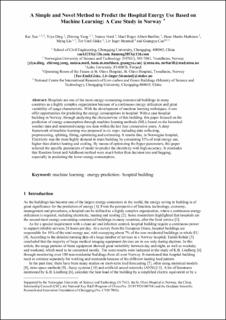| dc.contributor.author | Xue, Kai | |
| dc.contributor.author | Ding, Yiyu | |
| dc.contributor.author | Yang, Zhirong | |
| dc.contributor.author | Nord, Natasa | |
| dc.contributor.author | Barillec, Mael Roger Albert | |
| dc.contributor.author | Mathisen, Hans Martin | |
| dc.contributor.author | Liu, Meng | |
| dc.contributor.author | Giske, Tor Emil | |
| dc.contributor.author | Stenstad, Liv-Inger | |
| dc.contributor.author | Cao, Guangyu | |
| dc.date.accessioned | 2021-02-08T09:36:42Z | |
| dc.date.available | 2021-02-08T09:36:42Z | |
| dc.date.created | 2020-11-20T15:11:14Z | |
| dc.date.issued | 2020 | |
| dc.identifier.citation | Communications in Computer and Information Science. 2020, 1332 11-22. | en_US |
| dc.identifier.issn | 1865-0929 | |
| dc.identifier.uri | https://hdl.handle.net/11250/2726556 | |
| dc.description.abstract | Hospitals are one of the most energy-consuming commercial buildings in many countries as a highly complex organization because of a continuous energy utilization and great variability of usage characteristic. With the development of machine learning techniques, it can offer opportunities for predicting the energy consumptions in hospital. With a case hospital building in Norway, through analyzing the characteristic of this building, this paper focused on the prediction of energy consumption through machine learning methods (ML), based on the historical weather data and monitored energy use data within the last four consecutive years. A deep framework of machine learning was proposed in six steps: including data collecting, preprocessing, splitting, fitting, optimizing and estimating. It results that, in Norwegian hospital, Electricity was the most highly demand in main building by consuming 55% of total energy use, higher than district heating and cooling. By means of optimizing the hyper-parameters, this paper selected the specific parameters of model to predict the electricity with high accuracy. It concludes that Random forest and AdaBoost method were much better than decision tree and bagging, especially in predicting the lower energy consumption. | en_US |
| dc.language.iso | eng | en_US |
| dc.publisher | Springer | en_US |
| dc.title | A Simple and Novel Method to Predict the Hospital Energy Use Based on Machine Learning: A Case Study in Norway | en_US |
| dc.type | Peer reviewed | en_US |
| dc.type | Journal article | en_US |
| dc.description.version | acceptedVersion | en_US |
| dc.source.pagenumber | 11-22 | en_US |
| dc.source.volume | 1332 | en_US |
| dc.source.journal | Communications in Computer and Information Science | en_US |
| dc.identifier.doi | 10.1007/978-3-030-63820-7_2 | |
| dc.identifier.cristin | 1850473 | |
| dc.relation.project | Norges forskningsråd: 268248 | en_US |
| dc.relation.project | Norges teknisk-naturvitenskapelige universitet: 257660 | en_US |
| dc.description.localcode | "This is a post-peer-review, pre-copyedit version of an article. Locked until 17.11.2021 due to copyright restrictions. The final authenticated version is available online at: https://doi.org/10.1007/978-3-030-63820-7_2 | en_US |
| cristin.ispublished | true | |
| cristin.fulltext | postprint | |
| cristin.qualitycode | 1 | |
